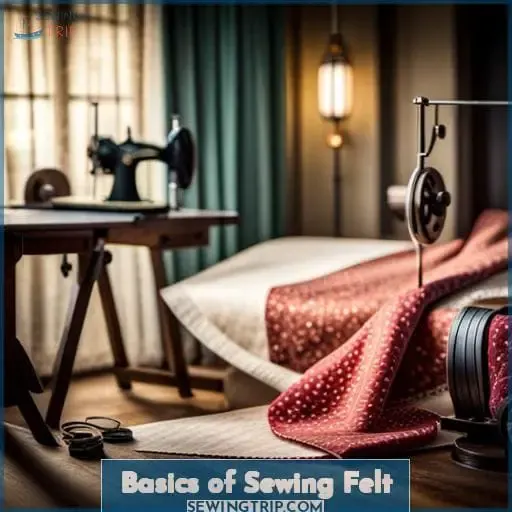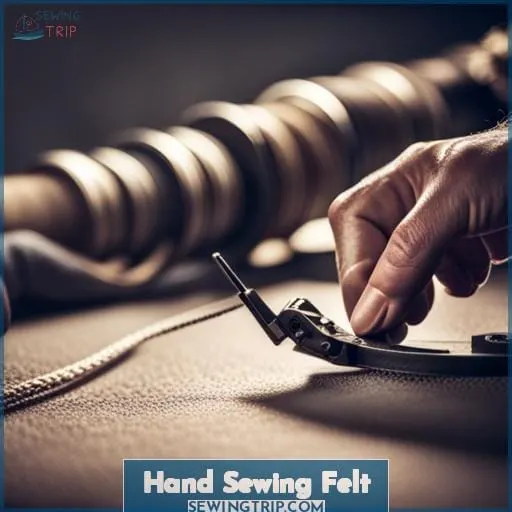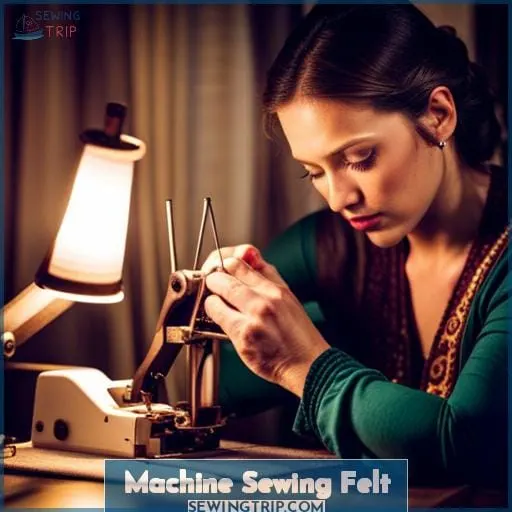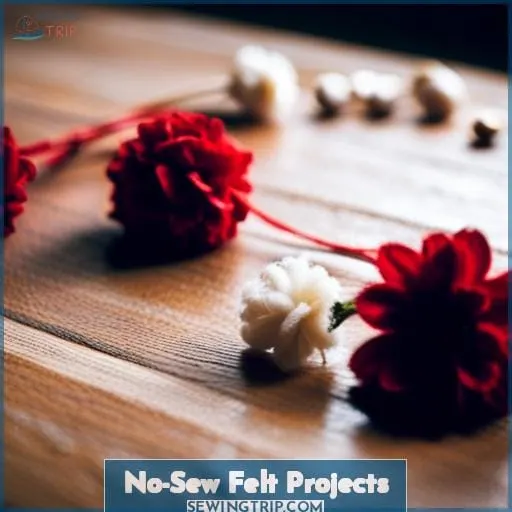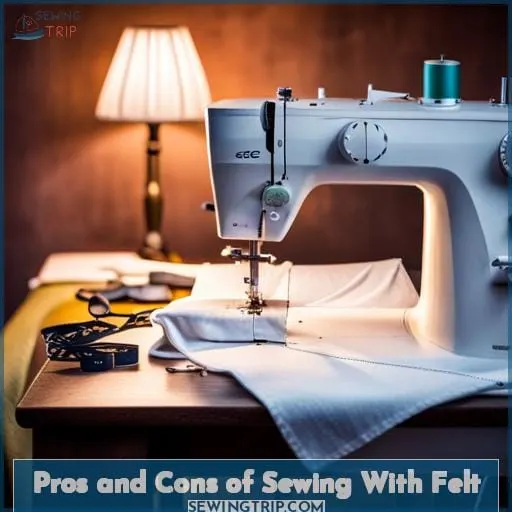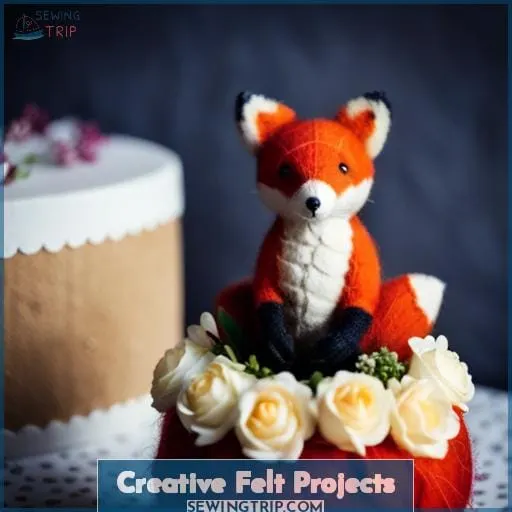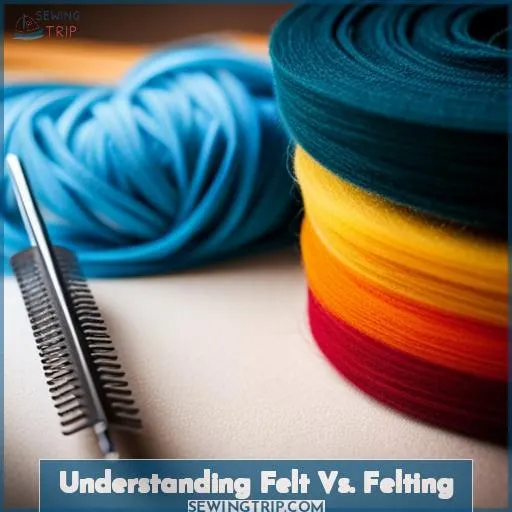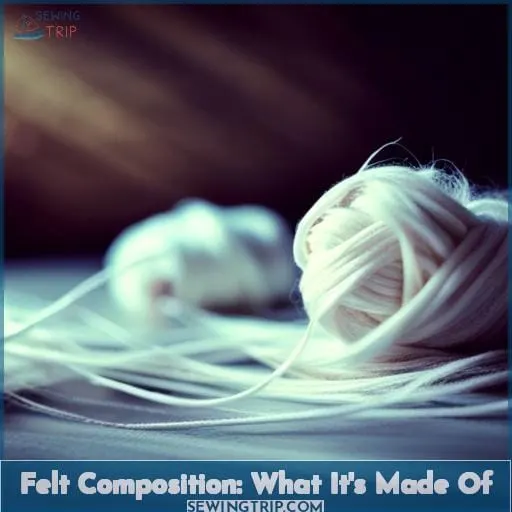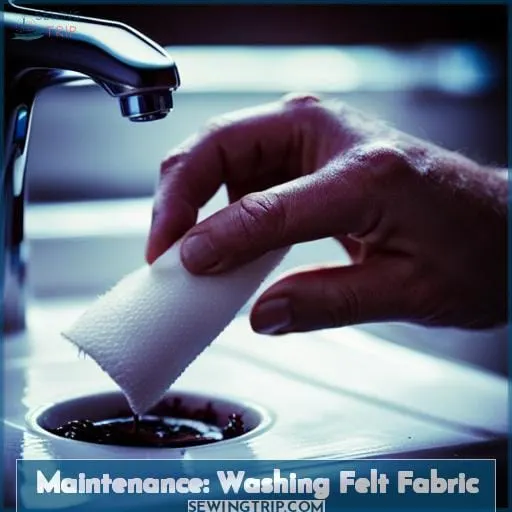This site is supported by our readers. We may earn a commission, at no cost to you, if you purchase through links.
 Mastering the art of sewing felt unveils a world of crafty control.
Mastering the art of sewing felt unveils a world of crafty control.
Delve into the tactile realm of felt, harnessing its versatility through hand and machine techniques.
Unravel the intricacies of needle selection, stitching finesse, and pattern crafting.
Explore the dichotomy between felt’s advantages and limitations, unleashing creativity in vibrant felt projects.
Gain mastery over this fabric, understanding its composition, maintenance, and the distinction between felt and felting.
Elevate your cloth crafting prowess with expert tips, projects, and a comprehensive understanding of sewing felt.
Table Of Contents
Key Takeaways
- Use a small to medium-sized sharp needle.
- Use a whip stitch or embroidery stitch.
- Machine sew felt with a short straight stitch or small zig-zag stitch.
- No-sew felt projects can be glued together, used with double-sided tape, spray adhesive, decoupage, or felt sheets.
Basics of Sewing Felt
When sewing felt, mastering basic stitches and techniques sets the foundation for your creative journey.
Explore the world of felt embellishment, where colorful appliqués and textured patchwork come to life.
Hand sewing and the precision of a sewing machine offer different dimensions to felt projects.
Dive into stitching innovations, discovering the art of creating detailed designs and intricate patterns.
Whether it’s crafting felted accessories or experimenting with various stitches for felt, understanding these basics opens doors to endless possibilities.
Start with the fundamentals to gain control and mastery, unlocking the potential for captivating and personalized felt creations.
Hand Sewing Felt
When hand sewing felt, mastering the art of tracing and cutting patterns becomes paramount.
Needle selection plays a crucial role in achieving seamless stitches, ensuring the right tool for the job.
Understanding various stitching techniques empowers you to create sturdy seams and intricate designs with finesse.
Tracing and Cutting Patterns
After familiarizing yourself with the basics of hand sewing felt, move on to tracing and cutting patterns, essential steps for creating precise shapes in your felt crafts.
Experiment with various embellishment techniques, adapting designs to your liking.
Explore fabric manipulation and color combinations for personalized projects.
Ensure accurate tracing and cutting to achieve the desired shapes and sizes, utilizing different types of felt for diverse felt patterns.
Needle Selection
Selecting a needle for hand sewing felt involves considering its size and sharpness.
- Opt for a small to medium-sized sharp needle, ensuring it easily pierces the felt without creating overly large holes.
- Match the needle to the felt thickness for precise stitches, preventing unnecessary damage.
Thread compatibility matters, too—use embroidery thread or sewing thread based on project complexity for seamless stitching and durable results.
Proper needle care ensures consistent performance.
Stitching Techniques
To master the art of hand-sewing felt, start by practicing the whip stitch technique for seamless joins between felt pieces.
Precision cutting sets the stage for flawless edges, ensuring a snug fusion.
Dive into embroidery intricacies, where each stitch contributes to the felt’s aesthetic appeal.
Embrace the versatility of felt crafts through these stitching techniques, unlocking a world of creative possibilities.
Machine Sewing Felt
Sure, you’re diving into machine sewing felt—start with precise patterns for your project, ensuring the right needle and thread match for optimal results.
Stitching two felt pieces together demands attention to needle size and thread thickness, ensuring a seamless, durable finish for your creation.
Get those essentials right, and you’re set for machine-sewn felt projects that truly stand out!
Preparing Patterns
To get started with machine sewing felt, prepare your patterns:
- Outline your design onto the fabric using tailor’s chalk or washable markers.
- Ensure precision by tracing templates accurately onto the felt, adjusting as needed for symmetry and fit.
- Carefully cut along the traced lines, maintaining clean edges for seamless assembly.
Proper pattern preparation sets the stage for precise and effortless machine sewing of your felt creations.
Choosing Needles and Thread
For machine sewing felt, opt for:
- A sharp, medium-sized needle
- All-purpose polyester thread
This will ensure smooth, precise stitches and secure seams.
Consider needle varieties suitable for felt and thread types compatible with the fabric.
Prioritize stitch variations for reinforced strength.
Stitching Two Pieces Together
When machine sewing felt pieces together, ensure you match the appropriate needles and threads for a smooth and secure stitch.
Use a short straight stitch or small zig-zag stitch with a needle size 70/10 or 80/12.
Fusible fleece can be added to felt projects for added stability and dimension.
No-Sew Felt Projects
No-Sew Felt Projects
If you don’t have a sewing machine or don’t want to sew, there are still plenty of ways to enjoy felt crafts.
- Glue felt together. You can use a glue gun, fabric glue, or even mod podge to adhere felt pieces together.
- Use double-sided tape. This is a great way to attach felt to other materials, such as cardboard or wood.
- Spray adhesive. This is a good option for attaching felt to fabric.
- Decoupage felt. This is a great way to add a decorative touch to your felt projects.
- Use felt sheets. These sheets come with adhesive backing, so you can simply peel and stick them together.
Here are 5 no-sew felt projects to get you started:
- <a href="https://www.craftsy.com/blog/2018/01/how-to-make-felt-flowers/”>Felt flowers
- <a href="https://www.thesprucecrafts.com/how-to-make-felt-flowers-5181984″>Felt colors
- <a href="https://www.allfreechristmascrafts.com/Felt-Christmas-Ornaments/”>Felt christmas ornaments
- <a href="https://www.thesprucecrafts.com/how-to-care-for-felt-1171166″>Felt fabric care
- <a href="https://www.joann.com/fusible-fleece-9-x-12-in-2-pk/10631171.html”>Fusible fleece
Pros and Cons of Sewing With Felt
Felt is a great fabric for beginners because it doesn’t fray and is easy to sew. It’s also available in a variety of colors and textures, so you can find the perfect felt for your project.
However, felt can be bulky and difficult to work with on a machine, so hand sewing is often the best option.
Advantages of Felt
With its forgiving nature and easy-to-sew qualities, felt is a great fabric for beginners to work with.
It’s durable, non-fraying, versatile, warm, insulating, affordable, and accessible.
It comes in a variety of colors and can be used for a variety of projects, from simple crafts to intricate sewing projects.
Limitations of Felt
Although felt is a versatile and easy-to-sew fabric, it can be flimsy, not durable, and can’t be washed, ironed, or made breathable.
Creative Felt Projects
Felt is a versatile material that lends itself to a variety of creative projects.
You can make:
- Felt ornaments
- Felt flowers
- Felt animals
- Felt toys
- Felt jewelry
With felt, you can create beautiful handmade gifts for your loved ones or simply add a touch of whimsy to your home décor.
Understanding Felt Vs. Felting
After you finish a felt project, you can felt it to make it even more durable.
Felting is a process that uses heat, moisture, and agitation to compress fibers together, creating a denser, stronger fabric.
| Felt | Felting |
|---|---|
| A type of fabric made from wool, fur, or other fibers that have been matted together. | A process that uses heat, moisture, and agitation to compress fibers together, creating a denser, stronger fabric. |
| Can be made by hand or machine. | Can be done by hand or machine, but needle felting is typically done by hand. |
| Is a finished product. | Is a process that transforms raw fibers into felt. |
| Can be used for a variety of projects, such as clothing, home décor, and accessories. | Can be used for a variety of projects, such as sculptures, jewelry, and wall hangings. |
History of Felting
Felting is an ancient craft that has been practiced for centuries. The earliest evidence of felting dates back to the Neolithic period, when felt was used to make clothing, shoes, and other items. Felting became increasingly popular in the Middle Ages, when it was used to make armor, hats, and other garments. In the modern era, felt is still used for a variety of purposes, including clothing, home décor, and accessories.
Felting vs. Needle Felting
Felting and needle felting are two different processes that produce different results. Felting is a process that uses heat, moisture, and agitation to compress fibers together, creating a denser, stronger fabric. Needle felting is a process that uses barbed needles to insert fibers into a base fabric, creating a textured surface.
Felting Tools
Felting can be done by hand or machine. Hand felting requires a few basic tools, such as a felting board, a felting needle, and some wool roving. Machine felting requires a felting machine and some wool roving.
Felting Projects
Felt can be used for a variety of projects, such as clothing, home décor, and accessories. Some popular felting projects include hats, scarves, mittens, bags, ornaments, and wall hangings.
Felt Composition: What It’s Made Of
Before you can start sewing with felt, it’s important to understand what it’s made of.
Felt is a natural, water-resistant fabric made from wool, acrylic, or rayon. It’s biodegradable, recyclable, lightweight, durable, non-toxic, and hypoallergenic.
Maintenance: Washing Felt Fabric
Most felt can be machine washed on a gentle cycle with cold water.
If hand washing, use cold water and mild soap.
Air dry flat to avoid stretching.
Avoid bleach and dryer sheets.
Spot clean felt with a mild soap and water.
Frequently Asked Questions (FAQs)
What is the difference between felt and fleece?
Felt is a non-woven fabric made from wool or other fibers, while fleece is a soft, napped fabric made from polyester or acrylic.
Can I use any type of needle to sew felt?
No, you can’t use any type of needle to sew felt.
Felt is a dense fabric that requires a sharp needle with a small eye to prevent the felt from fraying.
What is the best way to finish the edges of a felt project?
There are many ways to finish the edges of a felt project, but the most common is to simply zigzag stitch around the edges.
How do I sew felt on top of fabric?
To sew felt on top of fabric,
- Place the felt on top of the fabric and pin in place.
- Sew around the edges of the felt using a whip stitch or another hand-sewing stitch.
What are some tips for beginners who are learning to sew with felt?
As a beginner, you can start by:
- Choosing a simple project.
- Using a sharp needle and polyester thread.
- Taking your time to sew small, even stitches.
Conclusion
Sewing with felt is a versatile and rewarding craft that can be enjoyed by crafters of all skill levels. With a little practice, you’ll be able to create beautiful and unique felt projects that will add a touch of warmth and coziness to your home.

